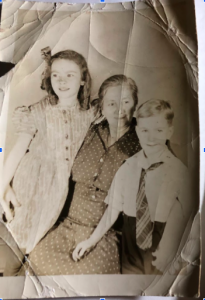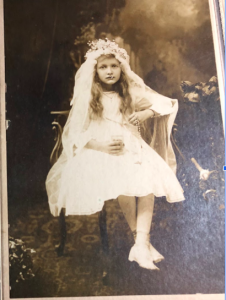I never knew the woman I was named after. She died in the early 90s, three weeks after she walked my mother down the aisle. Left behind were 7 adult children, a house that had been added on to at least once as the family grew over 16 years, and 3 things just for me. Of course, nobody knew that yet. I wasn’t born until nearly four years after her death, and even then parts of this treasure trove stayed hidden until 18 years later, tucked away in a faded cardboard box deep inside my mom’s closet.

My grandmother, Joan Frances Gillespie, was born on September 10, 1931, at 1505 Bailey Street in Philadelphia, Pennsylvania. She was the first child of Frances and Leo Gillespie, and she came home like her own first daughter-to the place where her grandparents, Robert and Catherine, lived. Catherine Wagner and Robert Crozier Kelly were an odd pair in ethnically divided Philadelphia. Catherine was the first German to marry into a long list of Irish Catholics that the family assumes started in Ireland during the famine (we haven’t gotten back quite that far in our family tree yet.) Frances Jane, their daughter, married an Irishman as was tradition. My grandmother and her younger brother Richard were mostly Irish and all Catholic.
The first thing my grandmother gave me was a name. Cecilia Joan isn’t exactly common, especially for a baby girl born in Charlotte, North Carolina, and it doesn’t fit into a cardboard box very well, but those names do fit in predominantly Irish South Philadelphia, the place they originated. Irish Catholics name their kids after saints. It’s a fact of the universe, just like gravity, and if you’re lucky like me, you get named after two saints. My grandmother was named after Joan of Arc and her mother Frances. According to my mother, her middle child, she definitely had that warrior spirit, something she probably picked up during the Depression when even living was a struggle. She took Cecilia as her Confirmation name, like her mother before her, and passed it to my mom, Joann Cecilia. I became Cecilia Joan. I wasn’t a big fan of having such a Catholic name, especially growing up in the South where nobody could spell it, but I grew into loving it. It’s a part of my grandmother I’ll have with me always.
The second thing she left me was also something too big to fit in that old cardboard box: Religion. The tenets of Catholicism have been the same since approximately 33 AD. My entire family definitely has them memorized because of Catholic school. For me, it wasn’t Catholic school, because of the exorbitant cost of a Catholic education in the South, but years of weekly Mass and religious education against my will. Catholicism is not only a religion but a culture, and during the Great Depression, it was a culture most Irish families, including my own, continued to support and rely on.
Catholicism in the 1930s did the opposite of Protestantism: It grew. According to Robert Handy, Catholic communities grew by 7% between 1932 and 1936 while their Protestant neighbors lost members of the community in what Handy calls “The American Religious Depression” (p. 13). A childhood in the Catholic church is a structured one, no matter when or where you grow up in it. My grandmother would have received her Baptismal Rites, First Reconciliation (confessing sins to a priest for the first time) and her First Communion during the Depression. Catholic churches baptize infants, and Pope Pius X approved a universal age of Communion, between 7 and 8, in 1910, before even my great grandmother received her own First Communion (Grondin). First Holy Communion is the third Sacrament my grandmother would have received during the Depression. It invites children to take the Eucharist, or the body and blood of Christ, for the first time, and be filled with his spiritual grace after a year of preparation and penance. Joan would have received her First Communion in 1939.

A First Communion is a celebration, and while we have no pictures of her on that day, I can imagine it. There’s always a white dress and a veil. My great grandmother received her First Communion in 1916 and I received mine in 2006, nearly 100 years later, and our outfits look almost identical. A little girl in the 1930s, used to frugal and spartan living, would have jumped at the chance to wear a dress like that and look like a princess for a day.
Looking like a princess and feeling like one were certainly very different things during the Great Depression. Philadelphia was hit particularly hard and early by the Great Depression. Even before the crash in October 1929, Philadelphia was seeing high unemployment and a stagnation of the market. The Depression hit in Philadelphia before it hit nationwide; by April of the same year, city-wide unemployment was already at 10%. Urban areas, like where my grandmother was born, were crumbling. At the time of the Great Depression, Philadelphia was a textile city. The textile industry was already undergoing changes that created strife as textile manufacturing became more popular in the South and the suburban and rural areas of Philadelphia. By 1933, only 40% of working age individuals in the city were employed at full hours. We don’t know how my great grandfather fared in the job market, but his job wasn’t a vital part of the Philadelphia economy, so he likely did poorly economically, and as the sole breadwinner, any loss of money on his part would have affected the family in a major way (Simon).
Childhood in the Great Depression was difficult, even for the affluent. My grandmother, an urban child of a homemaker and a die stamper with an 8th grade education, was anything but. My grandmother went to parochial private school during the Depression, so she was likely not affected by any crises the public schools faced. However, illness and malnutrition especially were effects my family suffered during the Great Depression. Nutrition was recognized by advocates as a severe concern for small children long before the 1930s, but the crash in 1929 made the threat grow (Lindenmeyer, 35). My grandmother’s baby teeth grew in rotted away from the lack of nutrition she received in my great grandmother’s breast milk. She remained short her entire life, possibly from the long term effects of the malnutrition she experienced as an infant and young child. Additionally, medical care was expensive and difficult to get. We know of at least one home remedy in the family that is also written about in “The Greatest Generation Grows Up” by Kriste Lindenmeyer.

My grandmother learned it from my great grandmother, and passed it down to her children. When they were sick, instead of buying commercial cough syrup, my grandmother would mix whiskey, honey, and sometimes tea and lemon juice to soothe the cough and the sore throat that accompanied it. As well as home remedies and rotting teeth, my grandmother was one of only two children to devout Irish Catholics. Given that she had seven herself, it seems likely that my great grandmother only had two children because of necessity. Poverty does not allow for large families, and childbearing during the Depression was often unsafe. The family believes that my great grandmother had a few miscarriages as well, likely because of the malnutrition mentioned above. We aren’t sure if my grandmother was a home birth or a hospital birth, and we can’t find records to tell us the answer. Kriste Lindenmeyer writes, “Home delivery was the most common birthing experience, especially for families with limited economic resources…” (34). It isn’t likely that a die stamper of greeting cards was a job considered necessary. It’s possible that my great grandfather was laid off or cut hourly. Given this, it’s safe to say that my grandmother was definitely limited economically, so it is more than possible she was literally born at 1505 South Bailey Street.
We don’t know very much about my grandma’s childhood. She died 25 years ago, and these are stories nobody thought anyone would ever need to know. Her brother is younger, and barely remembers the Depression at all, and their parents are dead. She never wrote down anything about it, and barely spoke about it. It was a traumatic experience for her, but she went on to live a happy life. Eventually my grandmother’s parents moved to the suburbs in Upper Darby, Pennsylvania, which my great uncle recently told my mother was the best decision they ever could have made. She graduated from Notre Dame High School (the third thing she left me was her class ring), married my Italian grandfather in what my mom calls a “mixed marriage” and had those 7 kids. Her skin was so fair that she’d sunburn through a shirt. When my uncle was no longer allowed to eat red dye, she started making her own candy so that all her kids got some. She made her children’s clothing. She disciplined with a firm hand and a wooden spoon like every Irish matriarch. My grandmother walked through the fire and came out ready to face the world, and face the world she did.
Works Cited
Barnard, Cecilia, et al. “Joan Frances Gillespie.” 2019.
Grondin, Father Charles. “A History of the Age for First Communion.” Catholic Answers, 2 Sept. 2017, www.catholic.com/qa/a-history-of-the-age-for-first-communion.
Handy, Robert T. “The American Religious Depression, 1925-1935.” Church History, vol. 29,1, 1 Mar. 1960, pp. 3–16. JSTOR,
www.jstor.org/stable/10.2307/3161613?refreqid=search-gateway:e9a635cc9ffb2dd7c4254b76a6021b43.
Lindenmeyer, Kriste. The Greatest Generation Grows up: American Childhood in the 1930s. Ivan R. Dee, 2007.
Simon, Roger D. “Great Depression.” Encyclopedia of Greater Philadelphia, 2013, philadelphiaencyclopedia.org/archive/great-depression/.